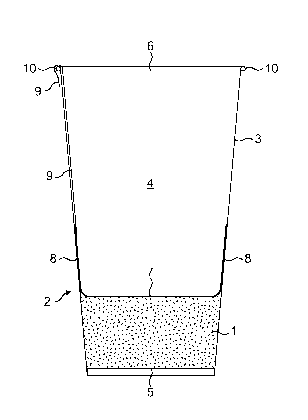Some of the information on this Web page has been provided by external sources. The Government of Canada is not responsible for the accuracy, reliability or currency of the information supplied by external sources. Users wishing to rely upon this information should consult directly with the source of the information. Content provided by external sources is not subject to official languages, privacy and accessibility requirements.
Any discrepancies in the text and image of the Claims and Abstract are due to differing posting times. Text of the Claims and Abstract are posted:
| (12) Patent Application: | (11) CA 2652912 |
|---|---|
| (54) English Title: | PACKAGED FOOD PRODUCT |
| (54) French Title: | PRODUIT ALIMENTAIRE CONDITIONNE |
| Status: | Deemed Abandoned and Beyond the Period of Reinstatement - Pending Response to Notice of Disregarded Communication |
| (51) International Patent Classification (IPC): |
|
|---|---|
| (72) Inventors : |
|
| (73) Owners : |
|
| (71) Applicants : |
|
| (74) Agent: | BORDEN LADNER GERVAIS LLP |
| (74) Associate agent: | |
| (45) Issued: | |
| (86) PCT Filing Date: | 2007-06-12 |
| (87) Open to Public Inspection: | 2008-01-10 |
| Availability of licence: | N/A |
| Dedicated to the Public: | N/A |
| (25) Language of filing: | English |
| Patent Cooperation Treaty (PCT): | Yes |
|---|---|
| (86) PCT Filing Number: | PCT/EP2007/055763 |
| (87) International Publication Number: | WO 2008003570 |
| (85) National Entry: | 2008-11-20 |
| (30) Application Priority Data: | ||||||
|---|---|---|---|---|---|---|
|
The present invention relates to a packaged food product (1) comprising a soluble product (1), a package (2) with a cup (3) having cup inner walls (4) defining an internal volume of the cup, a cup bottom (5), a cup opening (6), characterized in that said cup (3) further comprises an opercule (7) that is at least partially detachably sealed to the surface of the inner walls (4) of the cup (3) by sealing means, so that a predetermined portion of the internal volume of the cup is closed, said product (1) being packed in said closed cup portion.
La présente invention concerne un produit alimentaire conditionné (1) comportant un produit soluble (1), un emballage (2) comprenant un gobelet (3) ayant des parois intérieures (4) de gobelet définissant un volume interne du gobelet, un fond (5) de gobelet, une ouverture (6) de gobelet, caractérisé en ce que ledit gobelet (3) comporte par ailleurs un opercule (7) qui est au moins partiellement fixé de manière détachable sur la surface des parois intérieures (4) du gobelet (3) par des moyens de fixation, de manière à fermer une partie prédéterminée du volume interne du gobelet, ledit produit (1) étant conditionné dans ladite partie fermée du gobelet.
Note: Claims are shown in the official language in which they were submitted.
Note: Descriptions are shown in the official language in which they were submitted.

2024-08-01:As part of the Next Generation Patents (NGP) transition, the Canadian Patents Database (CPD) now contains a more detailed Event History, which replicates the Event Log of our new back-office solution.
Please note that "Inactive:" events refers to events no longer in use in our new back-office solution.
For a clearer understanding of the status of the application/patent presented on this page, the site Disclaimer , as well as the definitions for Patent , Event History , Maintenance Fee and Payment History should be consulted.
| Description | Date |
|---|---|
| Time Limit for Reversal Expired | 2013-06-12 |
| Application Not Reinstated by Deadline | 2013-06-12 |
| Deemed Abandoned - Failure to Respond to Maintenance Fee Notice | 2012-06-12 |
| Inactive: Abandon-RFE+Late fee unpaid-Correspondence sent | 2012-06-12 |
| Inactive: Cover page published | 2009-03-11 |
| Inactive: Office letter | 2009-03-09 |
| Inactive: Notice - National entry - No RFE | 2009-03-09 |
| Letter Sent | 2009-03-09 |
| Inactive: First IPC assigned | 2009-03-05 |
| Application Received - PCT | 2009-03-04 |
| National Entry Requirements Determined Compliant | 2008-11-20 |
| Application Published (Open to Public Inspection) | 2008-01-10 |
| Abandonment Date | Reason | Reinstatement Date |
|---|---|---|
| 2012-06-12 |
The last payment was received on 2011-05-18
Note : If the full payment has not been received on or before the date indicated, a further fee may be required which may be one of the following
Please refer to the CIPO Patent Fees web page to see all current fee amounts.
| Fee Type | Anniversary Year | Due Date | Paid Date |
|---|---|---|---|
| Basic national fee - standard | 2008-11-20 | ||
| Registration of a document | 2008-11-20 | ||
| MF (application, 2nd anniv.) - standard | 02 | 2009-06-12 | 2009-05-12 |
| MF (application, 3rd anniv.) - standard | 03 | 2010-06-14 | 2010-05-17 |
| MF (application, 4th anniv.) - standard | 04 | 2011-06-13 | 2011-05-18 |
Note: Records showing the ownership history in alphabetical order.
| Current Owners on Record |
|---|
| NESTEC S.A. |
| Past Owners on Record |
|---|
| FABIEN MINFRAY |